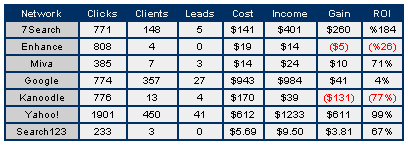Take 2nd Tier Ad Networks Seriously

| Don't Put Your All Your Advertising Eggs In One Basket |
|
If you are familiar with these pay per click (bid for placement) advertising networks, you are probably thinking to yourself "There is no reason to advertise on second-tier networks - I get all the traffic I need from the big players. There is nothing that a smaller PPC ad network can offer me that the services I currently use cannot." However, if advertising on those networks worked half as well as their marketing and public relations machines would have us believe, second tier ad networks such as Miva/Findwhat and 7Search.com would not exist.
What most small and medium sized business advertisers often do not realize (if you are not into the nitty-gritty of Internet advertising or do not live and breathe online media buying) is that these other networks not only exist but provide a comparable if not better return on investment (ROI) than either Yahoo! or Google Adwords.
The reason (most likely) is because people typically associate ROI with response rate or total revenue instead of the actual revenue they see from their advertising spends. Advertise at Yahoo! and there is no arguing that you will see triple the number of clicks and possibly twice the number of sign ups than the campaigns advertised at smaller PPCs. What you will also undoubtedly see is that the cost of running a campaign on Yahoo is exponentially higher (in individual bids and overall ad spend) which seriously impacts an advertiser's bottom line.
You Heard it Here First; It's All About the ROI
Essentially, more traffic in no way correlates to a better return on investment (ROI). If smaller pay per click advertising networks provide an equal return on investment (and often in some business verticals they do) these companies can not only survive but thrive in the competitive online advertising landscape.
Research conducted by Rich Leino of WebsiteMaven.com provides insight into the actual return on investment generated through these second tier networks.

Research was performed by following clicks from each PPC network and tracking them through to a conversion. A conversion is usually a sale but can be anything that the website owner desires for the user to do: register for a newsletter, join a forum, register in a contest, etc. By assigning a value to the conversion and by tracking the cost for each click that comes from a PPC network, it is possible to determine what the average cost for each click was as well as how much income, on average, each click generated.
Gain is calculated by subtracting the cost from the income. ROI is calculated as a percentage of gain divided by cost. An ROI of 100% means that for every $1 cost, there were $2 in income.
It is important to note that popular keywords performed very poorly for some second tier networks. A popular keyword is one that is searched for very frequently by consumers and, hence, sought after by advertisers. Research revealed that Yahoo! Search Marketing, Google Adwords, 7Search, and MIVA had excellent ROI for even the most competitive keywords while Kanoodle and Enhance performed extremely poorly due to apparent click fraud. On niche keywords, with less competition, the same PPC networks performed well while Enhance and Kanoodle continued to perform very poorly even for niche categories.
While it is hard to deny the benefits provided by both Yahoo Search Marketing and Google Adwords, it is essential for pay per click (also known as bid for placement) advertisers to utilize second tier networks to supplement traffic generated from the larger networks, as long as those second tier networks can provide a comparable return on investment. While no one in their right mind would suggest that website owners put all their advertising eggs in one basket, if you plan on getting out of the Internet henhouse with the most eggs (a high ROI) in tact you may want to consider using several different baskets.
| Instant Survey: 2nd Tier Pay Per Click |








